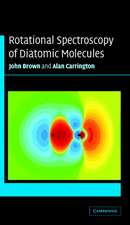Mass Spectrometry: A Foundation Course
Autor K. Downarden Limba Engleză Paperback – 31 aug 2004
Preț: 416.33 lei
Nou
Puncte Express: 624
Preț estimativ în valută:
79.66€ • 83.18$ • 65.93£
79.66€ • 83.18$ • 65.93£
Carte tipărită la comandă
Livrare economică 04-18 aprilie
Preluare comenzi: 021 569.72.76
Specificații
ISBN-13: 9780854046096
ISBN-10: 0854046097
Pagini: 210
Dimensiuni: 161 x 232 x 13 mm
Greutate: 0.38 kg
Editura: RSC Publishing
Locul publicării:United Kingdom
ISBN-10: 0854046097
Pagini: 210
Dimensiuni: 161 x 232 x 13 mm
Greutate: 0.38 kg
Editura: RSC Publishing
Locul publicării:United Kingdom
Cuprins
Mass Spectrometry's Beginnings; The Mass Spectrum; The Mass Spectrometer; Tandem Mass Spectrometry; Organic Mass Spectrometry; Ion Chemistry; Biological Mass Spectrometry; Mass Spectrometry in Medical Research; Mass Spectrometry in the Environmental and Surface Sciences; Accelerator Mass Spectrometry; Subject Index.
Recenzii
"Mass Spectrometry: A Foundation Course" accomplishes its goal with very few shortcomings....A text that does an exceptional job of introducing MS in a clearly written and logical fashion with sufficient depth for its intended audience of either undergraduate or graduate students......Kevin Downard has produced an excellent book, well-suited to the diverse audience he envisions..... certainly will be recommending it to both undergraduates and graduates seeking an introduction to MS"











